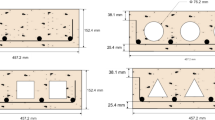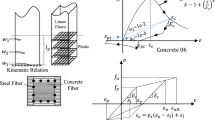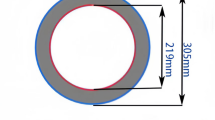Abstract
The accuracy and efficiency of the modelling techniques utilized to model the nonlinear behavior of structural components is a significant issue in earthquake engineering. In this study, the sufficiency of three different modelling techniques that can be employed to simulate the structural behavior of columns is investigated. A fiber-based finite length plastic hinge (FB-FLPH) model is calibrated in this study. In order to calibrate the FB-FLPH model, a novel database of the cyclic behavior of hollow steel columns under simultaneous axial and lateral loading cycles with varying amplitudes is used. By employing the FB-FLPH model calibrated in this study, the interaction of the axial force and the bending moment in columns is directly taken into account, and the deterioration in the cyclic behavior of these members is implicitly considered. The superiority of the calibrated FB-FLPH modelling approach is examined compared with the cases in which conventional fiber-based distributed plasticity and concentrated plasticity models are utilized. The efficiency of the enumerated modelling techniques is probed when they are implemented to model the columns of a typical special moment frame in order to prove the advantage of the FB-FLPH modelling approach.
Similar content being viewed by others
References
ASCE (2010), ASCE/SEI 7–10: Minimum Design Loads for Buildings And Other Structures, American Society of Civil Engineering.
AISC (2010), ANSI/AISC-360-10: Specification for Structural Steel Buildings, American Institute of Steel Construction, Chicago, Illinois.
AISC (2010), ANSI/AISC 340-10: Seismic Provisions for Structural Steel Buildings, American Institute of Steel Construction, Chicago, Illinois.
Bosco M, Ferrara GAF, Ghersi A, Marino EM and Rossi PP (2015), “Predicting Displacement Demand of Multi-Storey Asymmetric Buildings by Nonlinear Static Analysis and Corrective Eccentricities,” Engineering Structures, 99(Supplement C): 373–387.
Cheng X, Chen Y and Nethercot DA (2013), “Experimental Study on H-Shaped Steel Beam-Columns with Large Width-Thickness Ratios under Cyclic Bending about Weak-Axis,” Engineering Structures, 49: 264–274.
Coleman J and Spacone E (2001), “Localization Issues in Force-Based Frame Elements,” Journal of Structural Engineering-Asce, 127(11): 1257–1265.
Del Carpio RM, Mosqueda G and Lignos DG (2016), “Seismic Performance of a Steel Moment Frame Subassembly Tested from the Onset of Damage through Collapse,” Earthquake Engineering & Structural Dynamics, 45(10): 1563–1580.
Denavit MD, Hajjar JF, Leon RT and Perea T (2015), “Advanced Analysis and Seismic Design of Concrete-Filled Steel Tube Structures,” Structures Congress, Proceedings, 972–983. doi:https://doi.org/10.1061/9780784479117.083.
Denavit MD, Hajjar JF, Perea T and Leon RT (2016), “Seismic Performance Factors for Moment Frames with Steel-Concrete Composite Columns and Steel Beams,” Earthquake Engineering & Structural Dynamics, 45(10): 1685–1703.
Eletrabi H and Marshall JD (2015), “Catenary Action in Steel Framed Buildings with Buckling Restrained Braces,” Journal of Constructional Steel Research, 113(Supplement C): 221–233.
Farahi M and Mofid M (2013), “On the Quantification of Seismic Performance Factors of Chevron Knee Bracings, in Steel Structures,” Engineering Structures, 46:155–164.
Farahi M and Erfani S (2016), “Developing Representative Dual Loading Protocols for the Columns of Steel Special Moment Frames based on the Seismic Demands on These Members,” Journal of Earthquake Engineering, 21(8):1283–1304.
Farahi M and Erfani S (2017), “Employing a Fiber-Based Finite-Length Plastic Hinge Model for Representing the Cyclic and Seismic Behavior of Hollow Steel Columns,” Journal of Steel and Composite Structures, 23(5): 501–516.
FEMA P695 (2009), Quantification of Building Seismic Performance Factors, Federal Emergency Management Agency, Washington D.C.
Fenves GL and McKenna F (2007), “Computational Simulation for Earthquake Engineering Research and Practice,” Proceedings of Structural Engineering Research Frontiers, doi:https://doi.org/10.1061/40944(249)27.
Filippou FC, Popov EP, and Bertero VV (1983), “Effects of Bond Deterioration on Hysteretic Behavior of Reinforced Concrete Joints,” UCB/EERC 83-19, Earthquake Engineering Research Center, Berkeley, California.
Freeman SA (2000), “Performance-Based Seismic Engineering: Past, Current, and Future,” Proceedings of Advanced Technology in Structural Engineering Congress, doi:https://doi.org/10.1061/40492(2000)124.
Fu F (2009), “Progressive Collapse Analysis of High-Rise Building with 3-D Finite Element Modeling Method,” Journal of Constructional Steel Research, 65(6): 1269–1278.
Hall JF and Challa VRM (1995), “Beam-Column Modeling,” Journal of Engineering Mechanics, 121(12): 1284–1291.
Hamidia M, Filiatrault A and Aref A (2014), “Simplified Seismic Sidesway Collapse Analysis of Frame Buildings,” Earthquake Engineering & Structural Dynamics, 43(3): 429–448.
Ibarra LF, Medina RA and Krawinkler H (2005), “Hysteretic Models That Incorporate Strength and Stiffness Deterioration,” Earthquake Engineering & Structural Dynamics, 34(12): 1489–1511.
Ikeda K, Mahin SA and Dermitzakis SN (1984), “Phenomenological Modeling of Steel Braces under Cyclic Loading,” UCB/EERC-84/09, Earthquake Engineering Research Center, Berkeley, California.
Imanpour A, Tremblay R, Davaran A, Stoakes C and Fahnestock LA (2016), “Seismic Performance Assessment of Multitiered Steel Concentrically Braced Frames Designed in Accordance with the 2010 AISC Seismic Provisions,” Journal of Structural Engineering, 142(12): 04016135.
Jin J and El-Tawil S (2003), “Inelastic Cyclic Model for Steel Braces,” Journal of Engineering Mechanics, 129(5): 548–557.
Kanvinde A, Higgins P, Cooke R, Perez J and Higgins J (2014), “Column Base Connections for Hollow Steel Sections: Seismic Performance and Strength Models,” Journal of Structural Engineering, 141(7): 04014171.
Karamanci E and Lignos DG (2014), “Computational Approach for Collapse Assessment of Concentrically Braced Frames in Seismic Regions,” Journal of Structural Engineering, 140(8): A4014019.
Kawaguchi J and Morino S (2001), “Experimental Study on Post Local Buckling Behavior of Beam-Columns under Cyclic Loading,” Journal of Structural Construction Engineering, 540: 141–148.
Khatib F, Mahin SA and Pister KS (1988), “Seismic Behavior of Concentrically Braced Steel Frames,” UCB/EERC-88/01, Earthquake Engineering Research Center, University of California, Berkeley, California.
Kurata M, Nakashima M and Suita K (2005), “Effect of Column Base Behavior on the Seismic Response of Steel Moment Frames,” Journal of Earthquake Engineering, 9(2): 415–438.
Lignos D and Krawinkler H (2009), “Sidesway Collapse of Deteriorating Structural Systems Under Seismic Excitation,” Rep. No. TR172, John A. Blume Earthquake Engineering Center, Department of Civil Engineering, Stanford University, Stanford, California.
Lignos DG and Krawinkler H (2011), “Deterioration Modeling of Steel Components in Support of Collapse Prediction of Steel Moment Frames under Earthquake Loading,” Journal of Structural Engineering, 137(11): 1291–1302.
Menegotto M and Pinto PE (1973), “Method of Analysis for Cyclically Loaded Reinforced Concrete Plane Frames Including Changes in Geometry and Non-Elastic Behavior of Elements under Combined Normal Force and Bending,” Symposium on the Resistance and Ultimate Deformability of Structures Acted on by Well Defined Repeated Loads, International Association for Bridge and Structural Engineering, Zurich, Switzerland: 15–22.
Miyamura T, Yamashita T, Akiba H and Ohsaki M (2015), “Dynamic FE Simulation of Four-Story Steel Frame Modeled by Solid Elements and Its Validation Using Results of Full-Scale Shake-Table Test,” Earthquake Engineering & Structural Dynamics, 44(9): 1449–1469.
Nakashima M and Liu D (2005), “Instability and Complete Failure of Steel Columns Subjected to Cyclic Loading,” Journal of Engineering Mechanics, 131(6): 559–567.
Nobahar E, Farahi M and Mofid M (2016), “Quantification of Seismic Performance Factors of the Buildings Consisting of Disposable Knee Bracing Frames,” Journal of Constructional Steel Research, 124: 132–141.
Open System for Earthquake Engineering Simulation (OpenSees) [Computer software], OpenSees, Berkeley, California.
Salawdeh S and Goggins J (2013), “Numerical Simulation for Steel Brace Members Incorporating a Fatigue Model,” Engineering Structures, 46: 332–349.
Scott MH and Fenves GL (2006), “Plastic Hinge Integration Methods for Force-Based Beam-Column Elements,” Journal of Structural Engineering-Asce, 132(2): 244–252.
Scott MH and Hamutçuoğlu OM (2008), “Numerically Consistent Regularization of Force-Based Frame Elements,” International Journal for Numerical Methods in Engineering, 76(10): 1612–1631.
Tzimas AS, Kamaris GS, Karavasilis TL and Galasso C (2016), “Collapse Risk and Residual Drift Performance of Steel Buildings Using Post-Tensioned MRFs and Viscous Dampers in Near-Fault Regions,” Bulletin of Earthquake Engineering, 14(6): 1643–1662.
Ucak A and Tsopelas P (2014), “Load Path Effects in Circular Steel Columns under Bidirectional Lateral Cyclic Loading,” Journal of Structural Engineering, 141(5): 04014133.
Uriz P, Filippou FC and Mahin SA (2008), “Model for Cyclic Inelastic Buckling of Steel Braces,” Journal of Structural Engineering-Asce, 134(4): 619–628.
Vamvatsikos D and Cornell CA (2002), “Incremental Dynamic Analysis,” Earthquake Engineering & Structural Dynamics, 31(3): 491–514.
Author information
Authors and Affiliations
Corresponding author
Rights and permissions
About this article
Cite this article
Farahi, M., Erfani, S. Efficiency of employing fiber-based finite-length plastic hinges in simulating the cyclic and seismic behavior of steel hollow columns compared with other common modelling approaches. Earthq. Eng. Eng. Vib. 18, 777–794 (2019). https://doi.org/10.1007/s11803-019-0536-3
Received:
Accepted:
Published:
Issue Date:
DOI: https://doi.org/10.1007/s11803-019-0536-3




